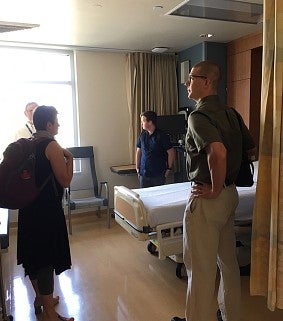The University of Oregon and Oregon Health & Science University have launched a study to learn how the new coronavirus is dispersed in the air and onto surfaces in the hospital setting, information vital to all hospitals, health care workers and the public.
The research is taking place at OHSU in Portland and the UO’s Biology and the Built Environment Center in the College of Design. The UO’s effort is led by architecture professor Kevin Van Den Wymelenberg, co-director of the center and director of the Institute for Health in the Built Environment.
“We hope the findings help optimize building operational parameters, such as fresh air rate and filtration, and eventually help guide the development of technology to monitor indoor microbiomes in real time to enhance safety,” Van Den Wymelenberg said.
“As Oregon’s academic health center, OHSU is built and maintained to meet rigorous state and federal regulatory standards and routinely meets or exceeds national benchmarks for quality and safety,” said Dr. Renee Edwards, senior vice president and chief medical officer for OHSU Health. “While our Infection Prevention and Control Program is well-equipped to manage any and all respiratory illness or infectious diseases, including COVID-19, there is much we don’t know about the virus. That’s why we are taking a proactive, evidence-based approach to better understand how the virus behaves in a hospital setting.”
The UO-OHSU is collecting samples, using swabs, active air or air captured by machine, and settled air in petri dishes in and around the rooms of patients with COVID-19. The team also will test hospital unit spaces, corridors and break rooms in the hospital.
The study not only will examine factors that affect the dispersal of genetic material from the coronavirus, also known as SARS-CoV-2, in the environment but also will explore new ways to determine whether any of this genetic material remains present in the form of virus particles that are potentially infectious.
“This could truly be a significant contribution,” said Dr. Robert Martindale, professor of surgery and chief of the Division of Gastrointestinal and General Surgery in the OHSU School of Medicine. “If we could design a room that could help minimize the spread of infections, we could change the way hospitals are built in the future.”
The study follows a paper Van Den Wymelenberg and others published in March that looked at ways to slow the spread of the coronavirus indoors. The paper included recommendations for disinfecting surfaces and increasing airflow from the outdoors, as well as other considerations such as humidity and disinfection practices.
The Biology of the Built Environment Center, founded in 2010 with support from the Alfred P. Sloan Foundation, studies the microbiome inside buildings, where people spend 90 percent or more of their time, especially lately. In collaboration with the UO Institute for Health in the Built Environment, the center has been collaborating with OHSU since 2018 on a study of health-care-associated infections and the relationship to architecture, specifically looking at factors that encourage the spread of bacteria responsible for a common infection found in hospitals.
In addition to Martindale, OHSU School of Medicine collaborators include Dr. Laszlo Kiraly, professor of trauma, critical care and acute care surgery; Dr. John Townes, professor of medicine and infectious diseases; Dr. Bill Messer, assistant professor of medicine, infectious diseases, and molecular microbiology and immunology; Dr. Alison Edelman, professor of obstetrics and gynecology; Dr. Amy Hermesch, assistant professor of obstetrics and gynecology; Dr. Bory Kea, assistant professor of emergency medicine; and Alec Hirsh, assistant professor, OHSU Vaccine and Gene Therapy Institute.

For example, Van Den Wymelenberg teaches Environmental Control Systems, which examines the influence climate, heating, cooling, lighting, acoustics, and water and waste systems on the design of buildings and sites, preparing students to help solve complex problems in areas of public health, climate change, social justice and more.
“As this pandemic is putting into sharp focus, design and human health are inseparable,” Moore said. “In the face of serious global challenges, it is especially important to develop aggressive, creative innovators who can connect the power of design with good science and rigorous ethical thinking.”
The established partnership, borne of the school’s interdisciplinary approach, eased the pivot to studying COVID-19, said Mark Fretz, associate director of outreach at the Biology and the Built Environment Center and an architecture research assistant professor.
“It’s a unique, interdisciplinary relationship — scientists and architects — that allows us to understand how design can influence patterns of behavior,” Fretz said. “There is tremendous value in working together with actual healthcare providers and patients in these environments.”
The UO team also includes Leslie Dietz, the built environment center’s wet lab manager and researcher, who will help gather and process samples.
When the new coronavirus appeared, Martindale said they immediately discussed if they could study it.
“It’s been a very fruitful relationship between us,” Martindale said. “The research partnership could be long lasting and widespread. I think it’s exciting to be working with architects.”
—By Alex Notman Cipolle, College of Design

